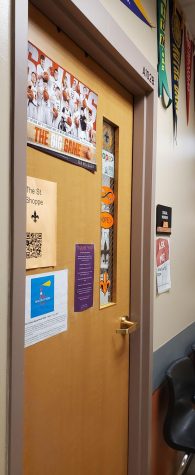Getting a grip on our mental health
It is no surprise that since 2020 when COVID-19 first hit the U.S, Americans’ mental health has been declining. Specifically, America’s youth has struggled the greatest.
According to the 2021 Mental Health of America Report, during the COVID-19 pandemic, “youth ages 11-17 have been more likely than any other age group to score for moderate to severe symptoms of anxiety and depression.”
Illinois is no exception. The report states that 62.1% of Illinois’ youth with major depression did not receive mental health services.
St. Charles East Social Worker, Michelle Otto, spoke about the impact the pandemic has had on students. “There’ve been students who’ve come in and talked about feeling disconnected, because last year they were fully remote and now they’re trying to get back into school and they feel like they’ve been away,” she said.
In order to combat the decline in students’ mental health, Illinois has passed a law allowing students to take up to five mental health days without the need of a doctor’s note. As stated in the bill, after a second mental health day is taken, the student “may be referred to the appropriate school support personnel.”
East’s nurse, Megan Mueller, spoke about how East intends to follow up with students. “After the second day, someone from the school will reach out. The assistant principals and the deans [are] working to make sure that no one falls through the cracks,” Mueller said.
She added that “Attendance would let the deans know and either a social worker or the dean will call.”
HOW CAN WE GET HELP AT SCHOOL?
In a recent interview with us, East Senior and HOPE Club member, Daniella Taylor, shared her hopes regarding the new mental health bill’s ability to destigmatize mental health.
“Oftentimes students do not view mental health as a reason to take a break, so I hope that this bill can change that,” stated Taylor.
“When students believe that their mental health is not a valid reason to take a break, it enforces the idea that mental health is not a priority.”
Taylor pointed out that the first step to erasing the stigma “is to stop villainizing people for taking much needed breaks and prioritizing themselves.”
Michelle Otto, who is a social worker at East, also shared her hopes in regards to the de-stigmatization of mental health. She emphasized the fact that people should not have to call in sick for a physical ailment in order to take a break mentally.

With or without a diagnosed mental illness, “we all have that [need for] emotional wellness,” said Otto.
“Stress is fluid. Sometimes we have things thrown at us and we need support a little bit more than a regular day.”
Courtney Pupich, another social worker at East, shared her thoughts about the new bill, specifically its impact on creating an appropriate balance in students’ lives. “A lot of students I work with have a lot of anxiety [and] practice a lot of avoidance and escape behaviors,” said Pupich.
For example, when a student with high anxiety has a big test, they might choose not to go to school.
“What that’s doing is training our brain and teaching us that when we have hard things to do, we escape and avoid them,” she said.
Although Pupich is fearful that the bill may amplify this problem, she also explained how it can help create a positive balance.
Similar to the point Taylor made, Pupich said, “I think the stressed out kids who take all these AP classes almost need an excuse to take a mental health day.”
Along with the support provided by the bill, East offers resources to students searching for help. Under the students and resources page on East’s website, students have access to a virtual calming room. This provides students access to resources, including Safe2Help Illinois, ReferralGPS, and various hotlines.
Safe2Help Illinois is a platform that provides simple, and impactful self help skills for students struggling with bullying, depression, self-injury and suicidal thoughts.
For example, students struggling with depression have access to a list of 99 coping skills, providing students with healthy coping mechanisms when feeling anxious. Students with a history of self-injury can utilize an exercise called Learning to Ride the Wave, which helps identify patterns in how one may feel or what they are doing right before feeling triggered.
ReferralGPS is an online tool that allows D303 community members to find mental health related services that best fit their needs. The website is completely anonymous, and takes users through a questionnaire to connect them with a mental health professional in their community.
Questions include what kind of help or the type of professional one is looking for, and a schedule of availability. The platform then generates a list of providers that best align with the given responses.
Despite these resources available to students, Taylor expressed her concerns around the idea that students cannot utilize resources if they are not aware they exist.
“I do not think the school does a great job of making sure students are aware of what resources are available to them,” she said. “Although I have heard of these resources, I don’t know how to access most of them.”
Pupich explained current efforts to raise awareness, which consist of educating students about resources available in the Student Services Department during their health class. “We go into those classes and talk about our services.”
She highlighted the role teachers play: “…those teachers do a really good job of trying to set kids up from the beginning and letting them know that this is where we are, this is what we do, and these are the resources we have.”
Pupich also said that this topic is covered in classroom days during PE. Since every student takes a mandatory health course and gym, the goal is that every student will know what resources are available to them from the beginning of high school.
Although many students are able to find the support they are seeking at East, Otto acknowledged that academically achieving students who are struggling may be going under the radar.
She explained that adults at East are oftentimes able to detect students who are struggling mentally due to the link between “a student’s social emotional wellness [and] their academics.”
However, if a student is in need of help, yet they have straight A’s, they may go unnoticed.
Otto pointed out that it’s important to acknowledge that East is a school, and ultimately the educators, Student Services personnel, and administrators “are here to support the academic environment.”
According to East’s website, school social workers assist students “whose social emotional and behavioral problems impact school performance.”
This is similar to the role of the student assistance counselor, who provides support when a student’s personal issues interfere with their learning.
Otto said that if a students’ mental health needs are not influenced by school or affecting their learning, they may need outside support.
“What we do in school is therapeutic, not therapy,” she said. Due to this, student services personnel are often working in conjunction with providers in the community.
Eliminating the stigma associated with mental health and ensuring that students have access to the resources they need is an ongoing problem that cannot be solved overnight. Since the start of COVID-19, and prior, Illinois, and specifically East, has taken action to combat these issues. Many students know they need help but are not always aware of the help that is out there. The X-ray staff conducted a survey and found out that, of those who responded, half were not aware of the “mental health day” option. (See survey results below.)

As Taylor said, “you are never going through mental health struggles alone and there is nothing to be ashamed of.” There are resources available for students. HOPE Club is working to get the message out there, too.
WHAT ELSE CAN WE DO TO HELP OURSELVES?
Reading can be a meditation of sorts. The escapism you feel from reading can distract you from daily stressors. It can help relax your body by lowering your heart rate and tension in your muscles.
A study in 2009 at the University of Sussex discovered that reading can “reduce stress by up to 68%” and “works better and faster than other relaxation methods, such as listening to music or drinking a hot cup of tea” according to Taking Charge of your Health & Wellbeing.
A campaign called Monday Campaigns created this reading practice to help destress:
Choose your own adventure. When choosing your reading material, ask yourself what genre suits your fancy today. Consult your own bookshelf, your local library, or get an e-book from the internet over the weekend – and start reading on Monday!
Find the time and place. You can always drop everything and pick up a book, but by setting aside a few minutes and designating a place to read, it will be easier to escape into your story.
Journaling is another healthy way to exert any overwhelming emotions. It’s a way to manage anxiety, reduce stress, and cope with mental health disorders such as depression.
According to the University of Rochester Medical Center, journaling helps control and improve your mood by “helping you prioritize problems, fears, and worries; tracking any symptoms day-to-day so that you can recognize triggers and learn ways to better control them; and providing an opportunity for positive self-talk and identifying negative thoughts and behaviors.”
Writing through your journal is a great way to identify these stressors in order to plan to resolve these problems and reduce your stress.
Here are some tips to help get started: Try to write every day. Set aside a few minutes (about 10-20) every day to write. This will help you to create a routine for journaling daily. Make it simple. Have a pen and paper handy. Then when you want to write down your thoughts, you can. Write or draw whatever feels right. Your journal doesn’t need to follow any certain structure. You don’t worry about spelling mistakes or what other people might think since this is your own private place for your thoughts.
Use your journal as you see fit. You don’t have to share your journal with anyone.
Exercising is another way of destressing and increasing your overall health and well-being. Through endorphins (your brain’s feel-good neurotransmitters), also known as “runner’s high”, it gives you a boost of energy.
The more you exercise, the more endorphins are produced since “physical activity may help boost the production” according to Mayo Clinic. This can help you get an extra pep in your step!
Working out can also protect your body from stress by imitating the effects of stress. With the “flight or fight response, and helping your body and its systems practice working together through those effects” it will result in positive effects on your cardiovascular, digestive, and immune systems according to Mayo Clinic. Any exercise would do, but most people tend to use “muscle meditation” as a form of workout. Walking and jogging are the main examples of it. Stretching workouts are also good.
Harvard Health Publishing recommends that “30 to 40 minutes of moderate exercise such as walking or 15 to 20 minutes of vigorous exercise” would be beneficial to achieve that healthy lifestyle. “You can do it all at once or in 10- to 15-minute chunks if that fits your schedule better.”
Foods can also play a role in your mental health. Eating comfort foods like cookies, chocolate, and ice cream can be a way to make you feel better when you’re in a bad mood. However, it unfortunately doesn’t mean they’re good for your health.
In The New York Times, it’s explained that “those foods typically offer a tantalizing combination of fat, sugar, salt, and carbs that make them hyper-palatable, they can actually make us feel worse.”
There’s a connection between our stomach and brain. Dr. Uma Naidoo, a Harvard psychiatrist and the director of nutritional psychiatry studies, said in the New York TImes that “the gut and brain originate from the same cells in the embryo.” And because they originated from the same brain, they connect to each other through the vagus nerve so they can have a two-way messaging chemical system.
This means your brain can affect chemicals like serotonin, which regulates mood, in your body. Dr. Naidoo says that “Only 5 percent of your body’s serotonin is made in the brain.” By eating specific foods, you’ll be able to regulate the serotonin that passes in your body and more. The more diverse your plate is, the better the food is for your brain.
There are also eating habits to take care of. According to the American Dietetic Association, “People tend to either eat too much or too little when depressed or under stress.”
Too much food can cause you to feel sluggish and gain weight. While eating too little food can result in exhaustion. A poor diet can result in worsening periods of stress and depression.
Foods like fruits and vegetables are rich in omega-3 fatty acids which are energy sources for your body.
For brain protection, dark green leafy greens are recommended for their vitamins to boost the immune system and support normal growth and development. Nuts, seeds, and legumes are antioxidants, good sources of fat, and protein.
Mental Health Graphic by Chloe Ladines.

Chloe is now in her fourth year on the X-ray staff. She likes to write news stories. She also likes to draw. She was planning to compete in the editorial...

Serena is a senior who has been a part of the X-Ray for all her years at East. She is the Features Editor and her favorite part about X-Ray is learning...







